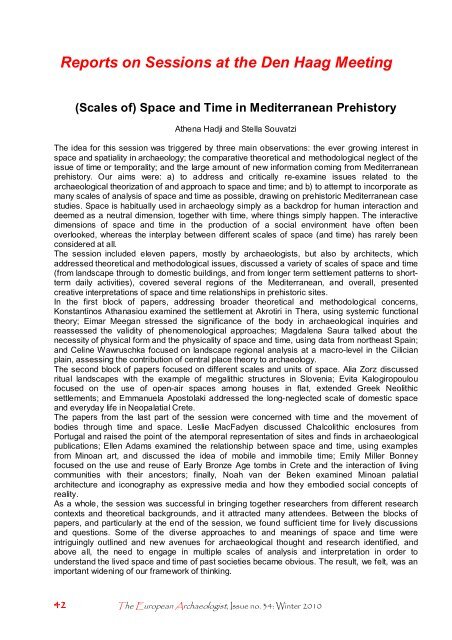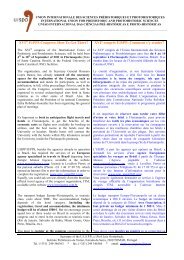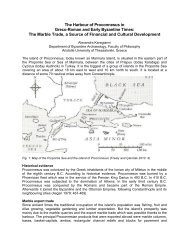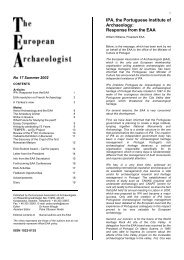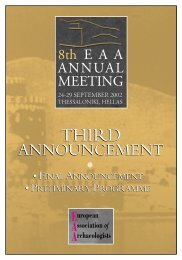TEA 34 - European Association of Archaeologists
TEA 34 - European Association of Archaeologists
TEA 34 - European Association of Archaeologists
Create successful ePaper yourself
Turn your PDF publications into a flip-book with our unique Google optimized e-Paper software.
Reports on Sessions at the Den Haag Meeting<br />
42<br />
42<br />
(Scales <strong>of</strong>) Space and Time in Mediterranean Prehistory<br />
Athena Hadji and Stella Souvatzi<br />
The idea for this session was triggered by three main observations: the ever growing interest in<br />
space and spatiality in archaeology; the comparative theoretical and methodological neglect <strong>of</strong> the<br />
issue <strong>of</strong> time or temporality; and the large amount <strong>of</strong> new information coming from Mediterranean<br />
prehistory. Our aims were: a) to address and critically re-examine issues related to the<br />
archaeological theorization <strong>of</strong> and approach to space and time; and b) to attempt to incorporate as<br />
many scales <strong>of</strong> analysis <strong>of</strong> space and time as possible, drawing on prehistoric Mediterranean case<br />
studies. Space is habitually used in archaeology simply as a backdrop for human interaction and<br />
deemed as a neutral dimension, together with time, where things simply happen. The interactive<br />
dimensions <strong>of</strong> space and time in the production <strong>of</strong> a social environment have <strong>of</strong>ten been<br />
overlooked, whereas the interplay between different scales <strong>of</strong> space (and time) has rarely been<br />
considered at all.<br />
The session included eleven papers, mostly by archaeologists, but also by architects, which<br />
addressed theoretical and methodological issues, discussed a variety <strong>of</strong> scales <strong>of</strong> space and time<br />
(from landscape through to domestic buildings, and from longer term settlement patterns to shortterm<br />
daily activities), covered several regions <strong>of</strong> the Mediterranean, and overall, presented<br />
creative interpretations <strong>of</strong> space and time relationships in prehistoric sites.<br />
In the first block <strong>of</strong> papers, addressing broader theoretical and methodological concerns,<br />
Konstantinos Athanasiou examined the settlement at Akrotiri in Thera, using systemic functional<br />
theory; Eimar Meegan stressed the significance <strong>of</strong> the body in archaeological inquiries and<br />
reassessed the validity <strong>of</strong> phenomenological approaches; Magdalena Saura talked about the<br />
necessity <strong>of</strong> physical form and the physicality <strong>of</strong> space and time, using data from northeast Spain;<br />
and Celine Wawruschka focused on landscape regional analysis at a macro-level in the Cilician<br />
plain, assessing the contribution <strong>of</strong> central place theory to archaeology.<br />
The second block <strong>of</strong> papers focused on different scales and units <strong>of</strong> space. Alia Zorz discussed<br />
ritual landscapes with the example <strong>of</strong> megalithic structures in Slovenia; Evita Kalogiropoulou<br />
focused on the use <strong>of</strong> open-air spaces among houses in flat, extended Greek Neolithic<br />
settlements; and Emmanuela Apostolaki addressed the long-neglected scale <strong>of</strong> domestic space<br />
and everyday life in Neopalatial Crete.<br />
The papers from the last part <strong>of</strong> the session were concerned with time and the movement <strong>of</strong><br />
bodies through time and space. Leslie MacFadyen discussed Chalcolithic enclosures from<br />
Portugal and raised the point <strong>of</strong> the atemporal representation <strong>of</strong> sites and finds in archaeological<br />
publications; Ellen Adams examined the relationship between space and time, using examples<br />
from Minoan art, and discussed the idea <strong>of</strong> mobile and immobile time; Emily Miller Bonney<br />
focused on the use and reuse <strong>of</strong> Early Bronze Age tombs in Crete and the interaction <strong>of</strong> living<br />
communities with their ancestors; finally, Noah van der Beken examined Minoan palatial<br />
architecture and iconography as expressive media and how they embodied social concepts <strong>of</strong><br />
reality.<br />
As a whole, the session was successful in bringing together researchers from different research<br />
contexts and theoretical backgrounds, and it attracted many attendees. Between the blocks <strong>of</strong><br />
papers, and particularly at the end <strong>of</strong> the session, we found sufficient time for lively discussions<br />
and questions. Some <strong>of</strong> the diverse approaches to and meanings <strong>of</strong> space and time were<br />
intriguingly outlined and new avenues for archaeological thought and research identified, and<br />
above all, the need to engage in multiple scales <strong>of</strong> analysis and interpretation in order to<br />
understand the lived space and time <strong>of</strong> past societies became obvious. The result, we felt, was an<br />
important widening <strong>of</strong> our framework <strong>of</strong> thinking.<br />
The <strong>European</strong> Archaeologist, Issue no. <strong>34</strong>: Winter 2010


